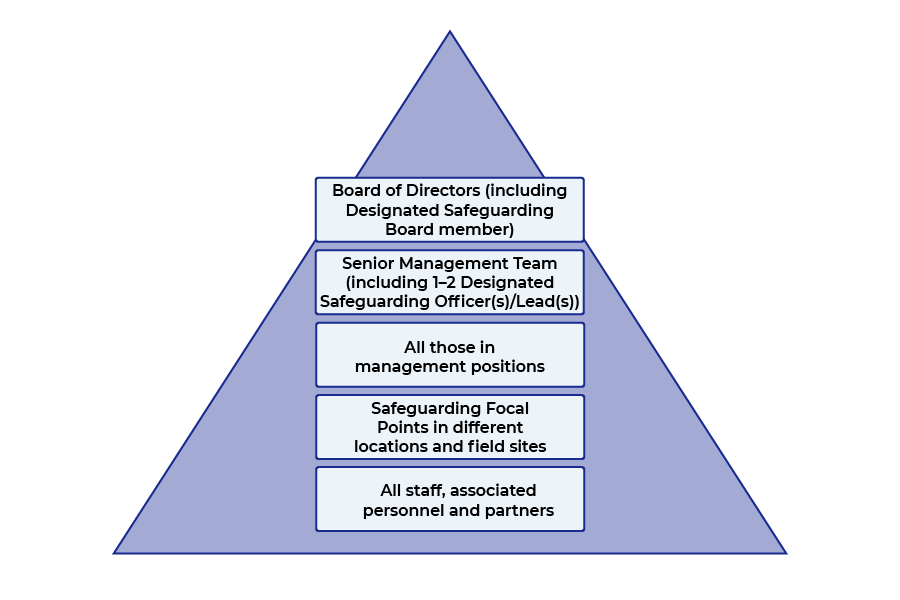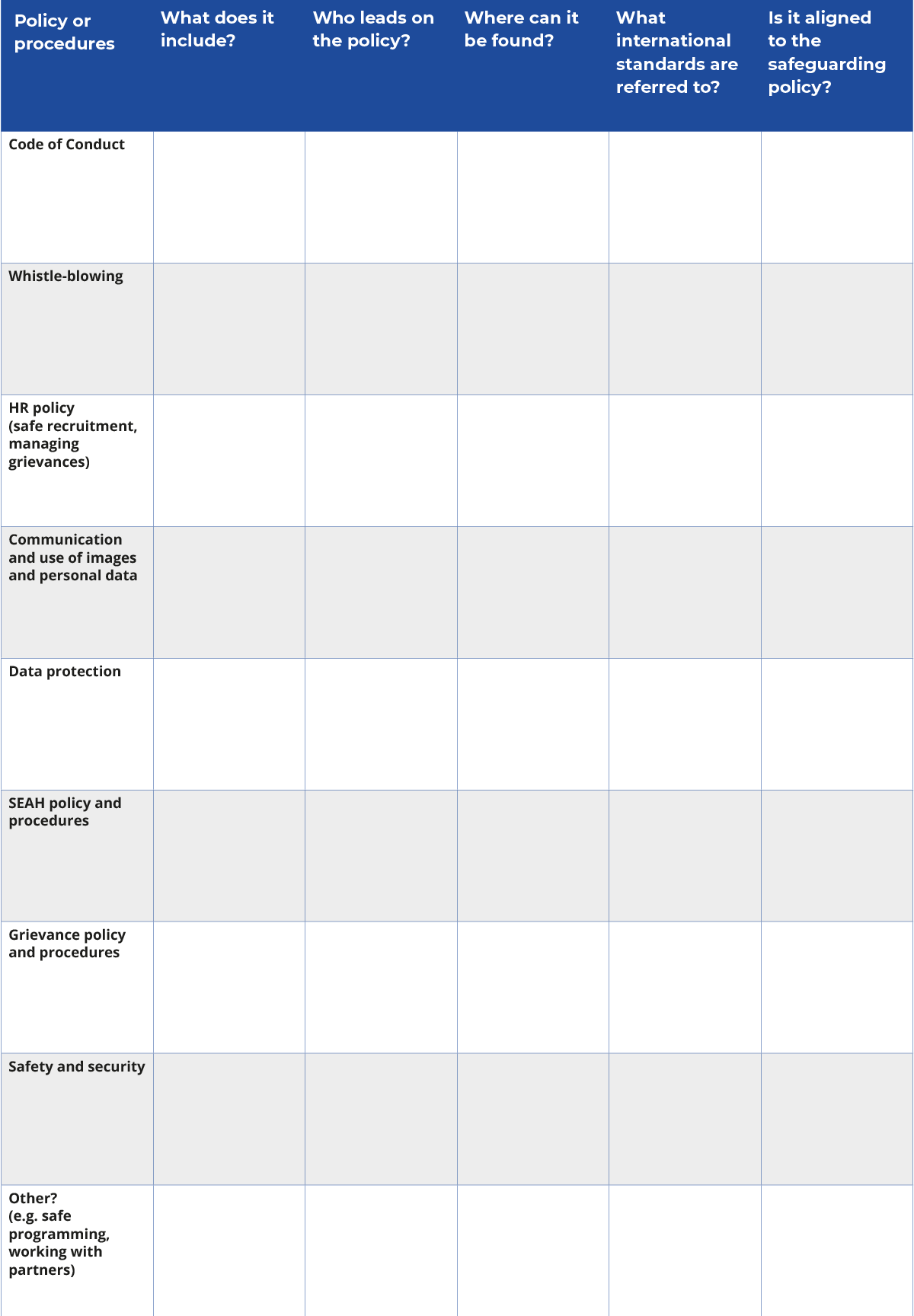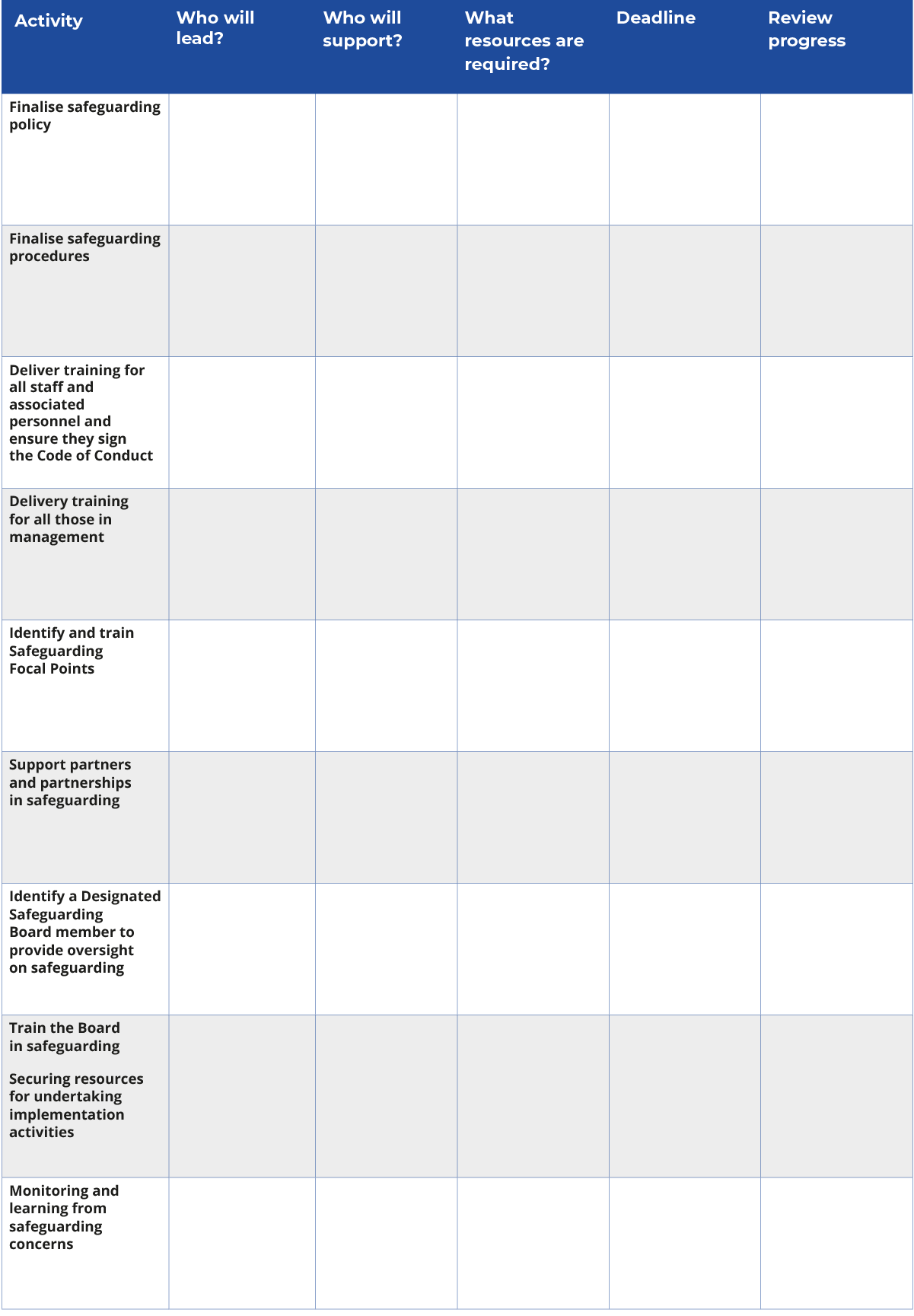Unit 6: Learning and implementation
| Site: | OpenLearn Create |
| Course: | Introduction to Safeguarding in the International Aid Sector |
| Book: | Unit 6: Learning and implementation |
| Printed by: | Guest user |
| Date: | Tuesday, 25 November 2025, 3:11 PM |
Table of contents
- The learning and implementation stage of the Safeguarding Cycle
- 6.1 Developing a learning culture in your organisation
- 6.2 Building capacity in your organisation
- 6.3 The role of Safeguarding Focal Points
- 6.4 Developing a safeguarding culture
- 6.5 Are your policies and procedures fit for purpose?
- 6.6 How to implement a safeguarding policy and procedures
- 6.7 Unit 6 Knowledge check
- 6.8 Conclusion to this Introduction to Safeguarding course
- 6.9 Reflecting on your progress. Celebrating your success. Deciding on your next steps.
- 6.10 What do you know now?
- 6.11 Acknowledgements
The learning and implementation stage of the Safeguarding Cycle
Congratulations! You’ve now reached the final part of the introductory course on safeguarding.
We return to the Safeguarding Cycle and look now at how to implement, monitor and learn from safeguarding concerns, which have been dealt with, so that your organisation is in a better position to prevent similar concerns from arising again.

So far, you have worked through the various parts of the Safeguarding Cycle: understanding definitions, identifying various forms of harm and concerns; putting in place prevention strategies, ensuring that there are accessible and confidential methods of reporting concerns ensuring that staff responsible for safeguarding are in a position to respond appropriately, referral mechanisms are ready to support survivors and you are clear about next steps.
In this final part of the course, we will look at:
- Ensuring your safeguarding policies and procedures are fit for purpose.
- Capacity building.
- Developing a healthy safeguarding culture.
- Working with partners.
- Developing an implementation, monitoring and evaluation plan.
- The role of management and the Board.
The week will conclude with a return to self-assessment to see how far you’ve journeyed on this course.
6.1 Developing a learning culture in your organisation
![]()
Watch the video above, in which safeguarding leads from INGOs talk about what they have learnt from previous safeguarding concerns.
Here are some top tips on developing a learning culture in your organisation.
Hold a learning review for all serious safeguarding incidents:
- An opportunity to reflect what went well and what could be improved.
- The learning review should be conducted independently.
- Each aspect should be recorded to support the thinking behind the conclusions reached.
Have a plan/method for taking the process forward:
- Set timeframe (e.g., six-monthly review).
- Have a clear action and allocate persons who are responsible for taking these plans forward.
Systemise and socialise the learning – be careful to anonymise confidential information:
- Share lessons organisation-wide through training and awareness-raising workshops, internal communications.
- Ability and flexibility to incorporate it into new systems/process.
- If applicable, obtain external expertise to guide organisational change.
An ongoing reflection of policies, procedures and processes:
- Learning should be continuous – not only triggered by an incident.
- Quarterly and annual reviews – to ensure practices are up to date with changes to standards or to how the organisational change operates.
6.2 Building capacity in your organisation

© eamesBot / Shutterstock
Developing a training plan to build capacity in your organisation.
It’s so important to build knowledge, awareness and capacity within the organisation with regards to safeguarding.
During this course, you have hopefully built-up sufficient knowledge and understanding of the subject and may already be thinking about how to pass this on to others. It is good practice and part of donor standards that safeguarding training be mandatory for all those who work or are associated with your organisation.
When developing a training module for staff and associated personnel, there are some things you will need to consider (if you have access to a learning and development advisor in the organisation, it’s a good idea to consult with them):
i) People learn in different ways using their different senses, so it’s a good idea to include different methods in the training session to keep their attention.
The four main types of learners are:
a. Visual – learn from images/drawings.
b. Auditory – learn from listening.
c. Kinaesthetic/Physical – learn by doing.
d. Theorists – learn by reading.
ii) Planning and preparation of materials are key. For example, avoid simply running through a policy or emailing information without explanation.
iii) Think about how much time you will need to deliver the training.
iv) Will it be face-to-face or online? If it’s the former, it should be a conducive and safe environment for learning and comfortable to accommodate all participants. If it’s the latter, you will need to find a time slot and an online platform that works for everyone with good connectivity (try to keep this slot half a day or less).
Aim for a good gender balance in the room if possible and ensure that people respect each other’s views and opinions. The sessions included in the template are only a guide.
|
Reflect on how to keep your messaging simple and clear. Consider the importance of avoiding jargon that will confuse participants. |
|
Activity 6.1 Developing a training plan Using the table below, think about how you might go about providing training on the topics in the middle column and make some notes about this in the end column. Also consider what materials and resources you might need for a safeguarding induction session. Here is a writable PDF version of the table. This activity is just to start you thinking about training – if you are not usually responsible for training this might be something you want to discuss with others in your organisation.
|
|
The Open University has created a training resource called Training Toolkit: Safeguarding in the International Aid Sector that is designed for those who are responsible for safeguarding in development or humanitarian contexts. |
![]()
Want to find out more?
If you are interested in reading more on training plans, follow the links below:
Safeguarding Resource and Support Hub - Introduction to Safeguarding
IASC Saying No to Sexual Misconduct (2020) (available in English, Arabic and Spanish)
Safeguarding course by DisasterReady.org Safeguarding and Protection
Online Child Safeguarding in Humanitarian settings course Safeguarding Essentials
6.3 The role of Safeguarding Focal Points
Once everyone has had their induction training into safeguarding, you will need to think about how this training can be replicated at the project level – particularly if your organisation is working in different locations in one country or in different countries. Also, who will be in a position to ensure safeguarding is kept on the agenda?
It’s good practice to identify persons at different offices, locations and field sites to undertake the role of Safeguarding Focal Points (SFP) or sometimes known as “Safeguarding Champions”. Safeguarding may be added on top of their usual work.
SFPs would be required to support staff and associated personnel to understand safeguarding responsibilities under the policy and be the ‘go to’ person for reports at the field level.
SFPs will require support, training and mentoring to carry out their tasks, which Designated Safeguarding Officers/Leads (who are usually at head offices, although not always) must consider in their plan. DSOs are those in senior positions who have the authority to make decisions.
The diagram below illustrates the responsibility for safeguarding in aid agencies.

![]()
Watch this video about Sherine, who loves being a Safeguarding Focal Point but finds it sometimes takes up a lot of her time.
For more detail on defining this role follow the link to:
Safeguarding Leads & Focal Points: Defining Your Role Worksheet
Develop a job description for a Safeguarding Focal Point

© D.Georgiev / Shutterstock
|
Activity 6.2 Developing a job description Use the list of questions below to start developing a job description for a Safeguarding Focal Point at field or project locations:
|
![]()
Want to find out more?
After compiling your ideas for a job description go to Plan International’s Guidance for Safeguarding Focal Points to see what other points you might have included.
What advice do you have for a new Safeguarding Lead or Focal Point?
![]()
Watch the video above, in which several people working in international organisations share some top tips about being a Safeguarding Lead or Focal Point.
6.4 Developing a safeguarding culture
Does your organisation have a healthy safeguarding culture?
Having the right policies and procedures in place is imperative to eradicate abuse, exploitation and harassment in the aid sector.
However, without the right organisational culture to challenge poor or abusive behaviour, these documents will not be implemented for the purpose they were intended. Organisational culture plays a crucial role in shaping and influencing behaviour in an organisation.
It is dynamic and shifts in response to external and internal factors in an organisation. Therefore, trying to measure and assess it is complicated, but it should be done so that changes can be put in place to improve it.
|
Activity 6.3 Your organisational safeguarding culture
Reflect on your organisational safeguarding culture using the checklist below. Here is a downloadable version of this table. Column 1 – is a list of criteria for a healthy safeguarding culture. Column 2 – has been left blank for you to complete on behalf of your organisation.
Column 3 – for those columns, which have been shaded orange or red, make a note of the various areas which can be improved in your organisation. When you have completed the exercise reflect on these questions: What did you learn? What improvements will you make to improve your organisational procedures?
(Adapted from Scotland’s International Development Alliance (2018) ‘Developing a Safeguarding Policy: Process Template’, December 2018. Scotland’s International Development Alliance. |
Working with partners on safeguarding

© Olivier Le Moal / Shutterstock
As part of implementing your programmes and projects, your organisation may be partnering with other organisations who have a closer relationship with beneficiaries and communities.
As part of your due diligence process, it’s important to not only share your organisational safeguarding policy and related policies with partners but to also agree safeguarding responsibilities of both organisation and support the development of capacity of partners (if needed) for everyone to understand their responsibilities when undertaking joint-programming or activities.
How do you define 'partner'
It is good practice that the lead organisations who provide funding undertake due diligence processes on potential partners, which includes safeguarding policies, procedures, practises and culture. Lead organisations should also share their policies with partners and undertake orientation of those.
Partners who receive funding and support should have policies of their own and if those policies are not adequate or require improvement, then partners should sign up to the policies of the lead agency and comply to these until such time that the partner has developed policies which meet international safeguarding standards.
Safeguarding should be a non-negotiable term in contractual documents with implementing partners. A failure to prevent, report or respond appropriately to safeguarding concerns by the implementing organisation could lead to suspension and eventual termination of the partnership.
|
Activity 6.4 Safeguarding and Partner organisations Consider the following questions and note any key points in your learning journal:
|
Implementing safeguarding during a pandemic
|
Activity 6.5 Safeguarding in Malawi
Watch the video above about how safeguarding is being implemented in Malawi during the COVID-19 pandemic, presentation by Malawi Scotland Partnership (MaSP).
After watching the video, reflect and respond to the questions below in your learning journal:
|
6.5 Are your policies and procedures fit for purpose?

© ESB Professional / Shutterstock
|
How do you develop your organisation’s safeguarding policy? Reflect on your current organisational policies and procedures to ensure they are fit for purpose. |
Many organisations have made the mistake of churning out safeguarding policies and procedures that are not fit for their purpose. For example, organisations may copy and paste some other organisation’s policy and simply change the name without any regard of whether it’s relevant to their needs or context.
Using the outline below and the learning so far covered in this course, check your existing safeguarding policy for your organisation. Remember your policy should be 4–6 pages (1,200–1,800 words) to get across your organisational commitment to safeguarding as its challenging to engage with long-winded documents. Your safeguarding policy can be supplemented with procedures and annexes with templates.
Does your policy have the following?
- The organisation is clearly described.
- Definitions in brief – what is safeguarding and why is safeguarding important to the organisation?
- A statement of the organisational commitment to safeguarding, including a zero-tolerance statement on bullying, harassment and sexual exploitation and abuse, and the consequences of breaching the organisational Code of Conduct.
- Who is bound by this policy and is to be held responsible for their behaviour?
- List of national or international laws, international standards that underpin or support the policy.
- List of preventative strategies that exist or will be put in place (see your previous notes from Part 3 of this course).
- Outline of the various ways safeguarding concerns can be reported and to whom.
- Outline of how concerns will be responded to by the organisation.
- How this policy will be implemented and monitored (more about this later).
- Other policies which are connected to this safeguarding policy which exists or will be developed (see next activity).
The safeguarding policy should be supplemented by the safeguarding procedures which provides the step-by-step guidance of the ‘how’ to do something mentioned in the policy.
For example, if the policy says that the organisation will carry out safe recruitment, the safeguarding procedures will detail how that will be done (see Unit 3 for idea). It could then have standardised templates or forms and other documents in the annexes.
Top tip:
- A ‘zero tolerance’ statement means that the organisation will and must take action against any infringement of the Code of the Conduct and organisational policies and will impose the highest penalty proportionate to the breach committed.
- If your organisation has signed-up to donor commitments or other international standards such as Sphere, CHS, Accountable Now, Keeping Children Safe, include reference to these in your policy.
Further reading on developing policies can be found following the next activity.
|
Activity 6.6 Aligning policies in your organisation Complete the table below with information about the policies that exist in your organisation in relation to safeguarding. This is likely to be something you will need to discuss with others in your organisation. Here is a downloadable version of this table. Apart from a safeguarding policy, consider other relevant policies that may cover different aspects, including staff harassment and bullying, child protection, data protection, media guidelines, safe programming, working with partners etc. After completing the form try to identify:
© Adapted from “Developing a Safeguarding Policy: Process Template by Scotland’s International Development Alliance” |
![]()
Want to find out more?
If you are interested in reading more on developing your policies, follow the links below:
- Developing a Safeguarding Policy Process Template, Scotland’s International Development Alliance
- Safeguarding Policy templates, Bond UK
- CHS PSEA Index
Alignment of policies – is it a problem?
![]()
Watch the video above to understand why it is important that all policies related to safeguarding are aligned with one another.
Non-alignment of policies could result in inconsistent implementation and effectiveness.
6.6 How to implement a safeguarding policy and procedures
By now, you have thought about how the existing organisational safeguarding policy and procedures can be improved on or where one did not exist, you have started developing it.
Having an implementation plan on how that policy is going to be rolled-out across the organisation is important otherwise it will just sit on a shelf and be brought out when donors want to have a look, which is not the idea.
Your organisation may consider having a ‘Safeguarding Working Group’ dedicated to monitoring the implementation across the entire organisation made up of the heads or focal points of each department so that each department is clear on their role and responsibilities. The plan should also include an induction and training schedule in creating a safe and healthy culture.
Every organisation should have a Designated Safeguarding Lead/officer at senior management level and Designated Safeguarding Board member at governance level. The Board members can monitor safeguarding, and safeguarding should become a standing item on the board agenda since it is a governance issue as all Board members can be held responsible for the actions of the workforce and associated personnel.
The next activity will help you explore how to develop an implementation plan.
|
Activity 6.7 A plan for implementing safeguarding good practice
Use the template below to develop a plan for implementing good safeguarding practice in your organisation. Here is a downloadable version of this table. The activities included are only suggestions and can be removed and new ones added. Remember supporting the organisation to implement safeguarding culture, policies and procedures is a joint responsibility of everyone so it’s important to try and find allies within the organisation and in other agencies to work with you and others on this plan.
© Adapted from “Developing a Safeguarding Policy: Process Template by Scotland’s International Development Alliance” |
|
Safeguarding is a journey for individuals and organisations. Reflect on what you have learnt on this course. Consider some of the basics you need to think about when trying to improve safeguarding within your own organisation or professional practice. |
6.7 Unit 6 Knowledge check
The end-of-unit knowledge check is a great way to check your understanding of what you have learnt.
There are five questions, and you can have up to 3 attempts at each question depending on the question type. The quizzes at the end of each unit count towards achieving your Digital Badge for the course. You must score at least 80% in each quiz to achieve the Statement of Participation and Digital Badge.
6.8 Conclusion to this Introduction to Safeguarding course
![]()
We hope you have enjoyed learning about safeguarding and how it’s an organisational responsibility.
We look forward to you joining us on course 2, where you will learn how to implement safeguarding measures in specific case studies and thematic areas of work that your organisation may be involved in.
6.9 Reflecting on your progress. Celebrating your success. Deciding on your next steps.

© Feodora Chiosea / iStock / Getty Images Plus.
Reflect on completing this Introduction to Safeguarding in the International Aid Sector course, review what you have learnt, think about the next steps on your learning journey and celebrate your success so far.
You have taken the first steps towards equipping yourself with the knowledge and skills you need to not only support your organisation’s efforts at safeguarding but also play your part in safeguarding those that you work with.
- In Unit 1, you were introduced to key ideas and concepts in safeguarding and learnt about why safeguarding matters.
- In Unit 2, you learnt how to identify safeguarding concerns and considered how and why harm occurs as a consequence of the misuse of power.
- In Unit 3, you focused on what organisations can do to prevent safeguarding concerns from arising. You learnt to identify the risks associated with those who work for or are engaged with your organisation when they are in contact with others.
- In Unit 4, you learnt about reporting mechanisms. Starting with the needs of survivors, you learnt about how to design and support effective reporting mechanisms.
- In Unit 5, you learnt about the causes and consequences of failing to effectively respond to safeguarding concerns and what organisations need to do to respond effectively.
- In this final unit of the course, you were introduced to organisational culture, training and the importance of learning through a consideration of the safeguarding strengths and weaknesses of your own organisation, what can be done to improve capacity and things to consider when working with partners.
As you approach the end of this course, it is important to remember that safeguarding is a journey. This course has introduced you to some of the basics you need to think about when trying to improve safeguarding within your own organisation or professional practice.
|
With this idea in mind, make a list of your five priorities as you continue your safeguarding journey and record these in your learning journal. These might be specific processes or actions to implement in your organisation, things you would like to learn more about, skills you’d like to develop or anything else that positively contributes to improving safeguarding. |
6.10 What do you know now?

© wenmei Zhou / iStock / Getty Images Plus
Congratulations! You have now completed the sixth and final unit of this course, Introduction to Safeguarding in the International Aid Sector.
At this point, we’d like to thank you for learning with us and taking your first steps on your safeguarding journey.
But before you go, in order to capture if this course has made any different to your knowledge and confidence, we would be very grateful if you could please complete this post-course assessment survey.
How do your responses now compare to the ones you gave at the beginning of the course?
6.11 Acknowledgements
Acknowledgement of Contributors
The following organisations have contributed to this course by providing feedback on drafts and contributing towards recorded interviews.
Médecins Sans Frontières International
The Queen’s Commonwealth Trust
Safeguarding Resource and Support Hub
Acknowledgement Report
Grateful acknowledgement is made to the following sources:
Video 1.1: Video: © The Open University / Images: Children: Image by Valéria Rodrigues Valéria from Pixabay; Village school: Pixabay; Guitar Lesson: Image by Valéria Rodrigues Valéria from Pixabay; Tents: Image by pakkalajuha from Pixabay; Hands: Image by Varun Kulkarni from Pixabay; Feet: Image by Varun Kulkarni from Pixabay; Meeting: Image by Dickson Donatus from Pixabay; Women: Image by erinbetzk from Pixabay; Fish: Image by Varun Kulkarni from Pixabay; Woman The photo was taken by Welcome to all and thank you for your visit! ツfrom Pixabay; Cooking: Image by Belajati Raihan Fahrizi from Pixabay; Farm: Image by Belajati Raihan Fahrizi from Pixabay; Children: Image by umberto battista from Pixabay; Oaxaca: Image by REBECA CRUZ GALVAN from Pixabay; Eritrea: Image by David Mark from Pixabay; Girl: Image by Parij Borgohain from Pixabay; Class: Image by andros1234 from Pixabay; Woman: Image by Jon Hoefer from Pixabay; Girl: Image by Varun Kulkarni from Pixabay; Road-side: Image by lifesecret from Pixabay; Smile: Image by Kasun Chamara from Pixabay; Group: Image by carlaborella from Pixabay; Poverty: Image by vleyva from Pixabay; Video Footage: Responding to a Child’s Disclosure of Abuse, NSPCC Learning: NSPCC, ‘Responding to a Child’s Disclosure of Abuse’ available online at https://youtu.be/bvJ5uBlGYgE; Video Footage: Responding to Disclosure of a GBV Incident: Global Cluster Shelter / IOM / USAID; Images: Help: Image by Gerardo Rojas from Pixabay; School: Image by David Mark from Pixabay; Book: Image by FireFX from Pixabay.
Videos 1.6, 2.1, 2.6, 2.11, 3.5, 3.8, 4.11, 4.12: Video: © The Open University / Images: World Humanitrian Day: MissChatZ / Envato Elements; Electronic Offline Map: barsrsind / Envato Elements; World Map Design: mamanamsai / Envato Elements; Man outdoors: MaxRiesgo / iStock / Getty Images Plus; iPhone/Chat Bubble/Call Center App Icons: creativevip / Envato Elements; Live Stream Producing On Laptop Illustration: barsrsind / Envato Elements; Audio: Cloth Whooshes Soft Whooshing Pass Bys: prosoundfx / Envato Elements; Pop 2: TibaSFX / Envato Elements; Chat App Pack: GameChestAudio / Envato Elements; Phone Text Typing: sonic-boom / Envato Elements; Video Chat Calling: JiltedGeneration / Envato Elements.
Video 1.7: © UNDP
Video 2.5: *** InterAction, ‘No Excuse for Abuse: Preventing Sexual Exploitation and Abuse in Humanitarian Action (English)’, https://www.interaction.org/blog/no-excuse-for-abuse/.
Video 2.9: © Inter-Agency Standing Committee (IASC) What if it were you?
Videos 2.13, 3.2, 3.11, 4.6, 4.8, 5.5, 5.6, 5.9, 6.1, 6.3, 6.4, 6.5: Video: © The Open University / Images: World Humanitrian Day: MissChatZ / Envato Elements; Electronic Offline Map: barsrsind / Envato Elements; World Map Design: mamanamsai / Envato Elements; Woman: PIKSEL
/ iStock / Getty Images Plus; iPhone/Chat Bubble/Call Center App Icons: creativevip / Envato Elements; Live Stream Producing On Laptop Illustration: barsrsind / Envato Elements; Audio: Cloth Whooshes Soft Whooshing Pass Bys: prosoundfx / Envato Elements;
Pop 2: TibaSFX / Envato Elements; Chat App Pack: GameChestAudio / Envato Elements; Phone Text Typing: sonic-boom / Envato Elements; Video Chat Calling: JiltedGeneration / Envato Elements.
Video 3.4: The New Humanitarian, www.thenewhumanitarian.org.
Video 3.9: ‘To Serve with Pride’ (2013) Inter-Agency Standing Committee Task force on protection from sexual exploitation and abuse, ECHA/ECPS, The Executive Committee on Humanitarian Affairs and Peace and Security, United Nations (UN) and Nongovernmental Organisation (NGO) Task Force on Protection from Sexual Exploitation and Abuse.
Video 3.14: Video © The Open University / Images: Adult: Image by Pexels from Pixabay; Volunteer: Image by Dimitris Vetsikas from Pixabay; Children and teacher: Image by Nick115 from Pixabay; Tents and children playing: Image by David Mark from Pixabay; Man on bike: Image by Charles Nambasi from Pixabay; Lady: Image by Nick115 from Pixabay; Boys: Image by Sonam Prajapati from Pixabay; Boy holding pole: Image by Rapheal Nathaniel from Pixabay; Girl: Image by Valéria Rodrigues Valéria from Pixabay; Young man: Image by fsHH from Pixabay; Lady: Image by Varun Kulkarni from Pixabay; Chatina Mexico: Image by REBECA CRUZ GALVAN from Pixabay.
Video 4.3: Our Grandfather Story - Were You Asking For It?
Video 4.4: The New Humanitarian, www.thenewhumanitarian.org.
Video 5.3: NSPCC, ‘Responding to a Child’s Disclosure of Abuse’ available online at https://youtu.be/bvJ5uBlGYgE.
Video 5.10: Global Cluster Shelter / IOM / USAID.
Video 6.8: Video: © The Open University / Images: Lady: PIKSEL / iStock / Getty Images Plus; Man: MaxRiesgo / iStock / Getty Images Plus; Students: Image by AkshayaPatra Foundation from Pixabay; Child: Image by Carina Chen from Pixabay; Children:
Image by criss_chengck10339 from Pixabay; Man reading book: Image by FireFX from Pixabay; Students studying: Image by Patricia Abena Kissi from Pixabay; Girl: Image by janeb13 from Pixabay; Students reading: Image by ludi from Pixabay.
Every effort has been made to contact copyright holders. If any have been inadvertently overlooked the publishers will be pleased to make the necessary arrangements at the first opportunity. Important: *** against any of the acknowledgements below means that the wording has been dictated by the rights holder/publisher, and cannot be changed.



